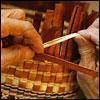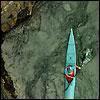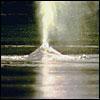Land


|
 |
 |
Nisqually Glacier
Formed when molten lava from ancient eruptions piled up, layer after layer, between monstrous glaciers, these are the breathtaking ridgelines along the flanks of Mt. Rainer.
|
|
 |
 |
 |
Palouse
A vast and mesmerizing shag carpet of wheat and earth east of the Cascades. It confronts and challenges its denizens, inviting the question: What natural forces did this?
|
|
 |
 |
 |
Basalt columns
The story behind the pocked and fissured Columbia Plateau is one of geology's most dramatic - and controversial - tales.
|
|
 |
 |
 |
Yellow Island
Isolation and natural purity make it a gem among some 400 or so other San Juan islands.
|
|
 |
 |
 |
Volcanoes
Mount St. Helens is only the latest and most visible pop star to rise out of the state's volcanic history.
|
|
 |
|
Sea


|
 |
 |
Deception Pass
Here flow some of the fastest, trickiest and most dangerous currents of our inland sea.
|
|
 |
|
 |
 |
 |
Jelly fish
Mysterious, luminous jellyfish, living lava lamps of Puget Sound, are some of the simplest and oldest animals on earth.
|
|
 |
 |
 |
Geoduck
The ungainly geoduck - the "King Clam" - lives 100 years or more and grows to epic size. It never moves and does practically nothing.
|
|
 |
 |
 |
Washington coast
Vast, powerful, primal, both ancient and ever-changing, the sea has an elemental pull.
|
|
 |
 |
 |
Gray whale
The grays' migration off the coast - one of the longest undertaken by any mammal - is one of the rites of spring.
|
|
 |
|
|
 |
|
Plant life


|
 |
 |
Blackberries
Our love-hate relationship with this wildly busy bush is never more clear in summer when blackberries makes us pay in blood for their sweet fruit.
|
|
 |
 |
 |
Bigleaf Maples
Shaggy and hulking as Sasquatch, bigleaf maples smothered in moss and ferns are lush, primeval and mysterious.
|
|
 |
 |
 |
Cedar trees
The Western Red Cedar is a delight to carve and its bark is cherished by weavers; fragrant and beautiful, the tree is a Northwest favorite.
|
|
 |
 |
 |
Skunk cabbage
Fresh and succulent, they look like something from the planet Venus, with blooms bright enough to earn skunk cabbage its nickname: Swamp Lantern.
|
|
 |
 |
 |
Sagebrush
Sagebrush is the signature of a vast and open landscape, scenting the air with the very essence of the West.
|
|
 |
 |
 |
Madrona tree
A massive madrona - believed to be more than 400 years old - has many admirers and protectors in Port Angeles.
|
|
Creatures


|
 |
 |
Dunlin
White-bellied, stiff-legged and with their high-pitched call of 'kree!,' dunlins are the shorebird of winter in Puget Sound country.
|
|
 |
 |
 |
Mountain goat
Monarchs of the high country, sure-footed mountain goats are bearded beasts built for tough terrain.
|
|
 |
 |
 |
Jelly fish
Mysterious, luminous jellyfish, living lava lamps of Puget Sound, are some of the simplest and oldest animals on earth.
|
|
 |
 |
 |
Green Drake
The late-June mayfly hatch lasts only for a few weeks, but draws fish and birds together on the river in such a feeding frenzy the water seems to come alive.
|
|
 |
 |
 |
Western Gray Squirrel
The population of the true Northwest squirrel is dropping so radically state wildlife officials are asking if it should be protected by the Endangered Species Act.
|
|
 |
 |
 |
Song Sparrow
The song sparrow is the clarion Lothario of the Northwest spring. Winter darkness mutes its song.
|
|
 |
 |
 |
Chorus frog
Their song, vernal, primal and just plan loud, can drown out traffic. Tiny enough to cuddle two to a saltine, chorus frogs are one of the first sounds of spring.
|
|
 |
 |
 |
Raven
The raven, largest of the songbirds, is smarter than its smaller urban cousin, the crow. Ravens don't live in cities like Seattle but on rare occasions can be seen passing through.
|
|
 |
 |
 |
Geoduck
The ungainly geoduck - the "King Clam" - lives 100 years or more and grows to epic size. It never moves and does practically nothing.
|
|
 |
 |
 |
Bald eagle
Hammered by civilization, the bald eagle retreated for decades to Alaska, British Columbia and our own San Juan Islands. Now, the bird has taken to the urban environs around Seattle.
|
|
 |
 |
 |
Rough-skinned newt
The orange-bellied, rough-skinned newt is one of the most poisonous creatures going.
|
|
 |
 |
 |
Majestic elk
The Roosevelt elk can run as fast as a horse, are strong enough to break logs and are excellent swimmers — all on a vegetarian diet of about 60 pounds of greens a day.
|
|
 |
 |
 |
Gray whale
The grays' migration off the coast - one of the longest undertaken by any mammal - is one of the rites of spring.
|
|
 |
|
Other Phenomenon


|
 |
 |
Clouds
Here they come: clouds in a thousand shades of gray. From now until July, we are in the company of vapors, scribbled skeins of mist and murk.
|
|
 |
 |
 |
Chanterelle
Deep in the sweet-smelling forest, a succulent treasure glows: the chanterelle mushroom, a herald of autumn and epicure's delight.
|
|
 |
 |
 |
Snow
A gift from above that defines the Northwest. Snowmelt spins our hydroelectric turbines, irrigates our crops and nudges salmon fingerlings out to sea.
|
|
 |
|






































